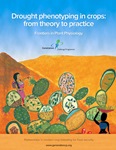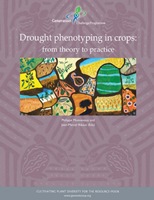Drought phenotyping in crops: from theory to practice (2014)
Back to: Drought phenotyping in crops homepage | Back to: Research publications | Back to: Books 2011
Drought phenotyping in crops: from theory to practice (2011)
Back to: Drought phenotyping in crops homepage | Back to: Research publications | Back to: Books 2011
This volume, published under a Creative Commons licence, to ensure the widest possible dissemination, is a detailed description and analysis of the complex work of drought phenotyping in crops, simultaneously tackling both the theoretical and practical aspects. It is written for both practitioners and postgraduate students of plant science grappling with the challenging task of evaluating germplasm performance under different water regimes. Part I is a methods section: different methods are presented for accurately characterising environmental conditions, implementing trials and capturing and analysing the information this generates, regardless of the crop. Part II is dedicated to application to specific crops. It presents the state-of-the-art in research on adaptation to drought, and recommends specific protocols to measure different traits in 14 major food crops (bananas and plantains, beans, cassava, chickpeas, cowpeas, groundnuts, maize, pearl millet, pigeonpeas, rice, sorghum, sweet potatoes and wheat).
|
|||||||||||||||||||||||||||||||
View or download the e-book: |
|||||||||||||||||||||||||||||||
|
|||||||||||||||||||||||||||||||
|
|||||||||||||||||||||||||||||||
Physiological breeding I: Interdisciplinary approaches to improve crop adaptation (wheat)
Back to: Books 2012
Published by CIMMYT, this book outlines the theoretical basis for phenotyping, and touches on molecular breeding and crop management − both of which have implications for phenotyping and physiological traits. Part I below has four main sections: i) improving yield and other target traits ii) phenotyping iii) molecular markers and their application, and, iv) sustainable cropping systems.
GCP was one of the the funders for CIMMYT's physiological breeding initiatives that are the basis of this book, which is presented below in e-book format
Hover over each graphic to see the contents of each section.
Download or view the entire book |
|||||||
|
|||||||
|
Download or view each section |
|||||||
|
|
|||||||
Proceed to Part II: Physiological breeding II: A field guide to wheat phenotyping
Physiological breeding II: A field guide to wheat phenotyping
Back to: Books 2012
Part II of this volume covers i)canopy temperature, stomatal conductance and water relation traits ii) spectral reflectance indices and pigment measurement iii) photosynthesis and light interception iv) direct growth analysis v) crop observations, and vi) general recommendations.
Download or view the entire book |
||
|
||
| Download or view each section | ||
 |
|||
 |
 |
 |
 |
 |
 |
 |
 |
Drought phenotyping in crops: from theory to practice
Back to: Research publications | Back to: Books
Published under a Creative Commons licence for the widest possible dissemination, this book is a unique attempt to simultaneously tackle theoretical and practical aspects in drought phenotyping, through both crop-specific and cross-cutting approaches. It is designed for – and will be of use to – practitioners and postgraduate students in plant science, who are grappling with the challenging task of evaluating germplasm performance under different water regimes.
In Part I, different methodologies are presented for accurately characterising environmental conditions, implementing trials, and capturing and analysing the information this generates, regardless of the crop.
Part II presents the state-of-art in research on adaptation to drought, and recommends specific protocols to measure different traits in major food crops (focusing on particular cereals, legumes and clonal crops).
The book is part of the CGIAR Generation Challenge Programme’s efforts to disseminate crop research information, tools and protocols, for improving characterisation of environments and phenotyping conditions. The goal is to enhance expertise in testing locations, and to stimulate the development and use of traits related to drought tolerance, as well as innovative protocols for crop characterisation and breeding.

This work is licensed under a Creative Commons Attribution-NonCommercial-ShareAlike 4.0 International Licence
|
|||||||||||||
























































